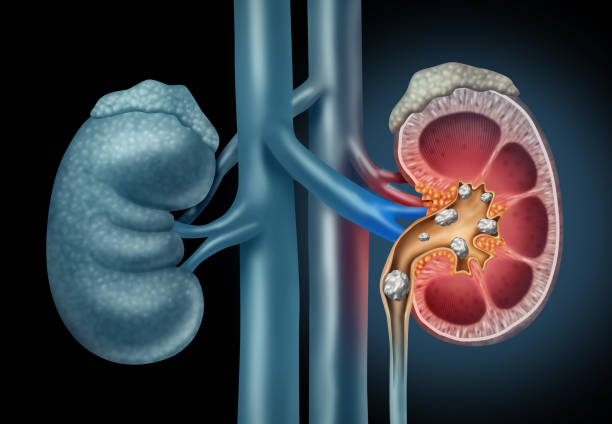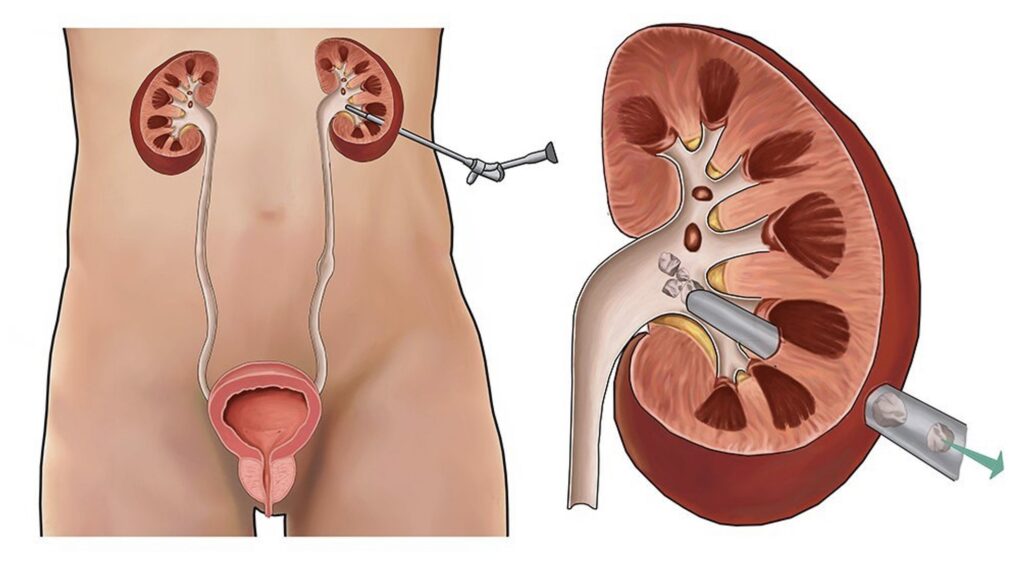Kidney stones or renal calculi form as a result of an increased amount of toxic waste in the urine. While most kidney stones usually pass on their own naturally, large stones may obstruct the urinary passage and require surgical intervention. Aapka Care provides USFDA-approved advanced kidney stone treatment in India that offers faster recovery and minimal hospital stays. Modern kidney stone procedures involve shockwave therapy (ESWL), laser procedures (URSL & RIRS), and minimally invasive surgery (PCNL). Contact Aapka Care to book a FREE appointment with the best kidney stone specialist for a safe and cost-efficient treatment.
URSL
PCNL
RIRS


Diagnosis
The urologists need to make some assessments before performing URSL. These assessments are made through a couple of diagnostic tests, including Imaging tests (X-ray, Abdominal Ultrasound, MRI), Blood Urea Nitrogen (BUN) test, Blood Test, and Urinalysis. The aim of carrying out these assessments is to figure out the size of the stone, the number of stones that need to be removed, and their location.
These tests also help doctors look for any underlying diseases that can cause complications in the procedure. The urologists will proceed with the procedure only after assessing the results of the tests carefully.
Procedure
This surgery is performed in the following steps:
- The patient is administered spinal or general anesthesia, depending upon the requirement.
- Then, the surgeon inserts a thin, long fiber-optic scope called a ureteroscope into the ureteral passage through the urethra. Simultaneously, the surgeon uses x-ray to see inside the kidneys and ureters and locate the stones exactly.
- Once the stone is located, it is collected in a stone basket and eventually pulled out of the system.
- If the stone is too large in size, then the surgeon uses a precision laser to break it into smaller pieces. The small stones can pass through the system naturally.
- The surgeon usually inserts ureteral stents to help flush out the stones from the body. The stent expands the passage of the ureter, which makes it easier for the stone fragments to travel through the ureter and out of the body.
If you’re about to undergo URSL surgery, it is advisable to prepare yourself for the surgery in advance. This includes following some precautions and making some lifestyle changes to promote the effectiveness of the surgery. Here are some ways in which you can prepare for your URSL surgery:
- Talk to your doctor and discuss your symptoms, medical history, and other important details in advance. You can also ask the doctor to explain the treatment procedure in advance and the risks associated with it.
- If you’re taking some medication, convey it to your doctor in advance. The doctor might ask you to discontinue some medicines before surgery, such as blood thinners, etc.
- If you’ve had an allergic reaction to anesthesia in the past, make sure your doctor is aware of this detail. An allergic reaction to anesthesia can delay the surgery, and may also lead to other complications.
- Avoid eating or drinking anything 6 to 8 hours before the surgery. This measure helps in preventing complications related to anesthesia.
- Stop smoking or using any product that contains tobacco as it might affect the effectiveness of the surgery.
URSL is a modern technique to treat kidney stones, and offers a respite from the painful condition while causing no discomfort to the patient. This is a minimally-invasive procedure i.e., it does not involve cuts or stitches which allows the patient to remain comfortable throughout..Some of the benefits of ureteroscopic lithotripsy include the following –
- No cuts and scars
- No bleeding during the surgery
- Faster recovery
- Minimal complications
- Shorter hospital stay
- Outpatient procedure
- Resume daily activities within a week
Most patients with refractive errors benefit from LASIK treatment. LASIK or Laser In-Situ Keratomileusis is a painless procedure that uses the latest laser technology and high-quality intraocular lenses (IOLs) to ensure negligible chances of complications. There are several benefits of LASIK surgery for both medical as well as aesthetic reasons. Some of the advantages of LASIK surgery are as follows –
- Around 96% of patients regain their vision
- Cures refractive errors like myopia, hyperopia, and astigmatism
- Minimally invasive procedure
- No visible cuts or scars
- No major pain as compared to other surgeries
- Negligible chances of risks and complications
- Permanently eliminates the need for glasses or contact lenses after the procedure
Before PCNL surgery, your doctor will give you some instructions to help you prepare for the surgery. Following these preoperative preparation tips will not only help you prepare for the operation but will also help you remain calm throughout. Here’s how you can prepare yourself for the PCNL surgery:
- Get all your questions answered beforehand. This can include questions about the procedure, the severity of the condition, the risks associated with the surgery, and so on.
- If you’re allergic to anesthesia, make sure the doctor is aware of it. This will help you remain at bay from developing allergic reactions to anesthesia.
- Do not eat or drink anything for approximately 6 to 8 hours before the surgery to prevent anesthesia-related complications.
- The doctor might also ask you to discontinue certain medicines, such as blood thinners, before the surgery.
Complete recovery after PCNL surgery takes about 4 to 6 weeks. However, the recovery period can vary from person to person. The doctor will give you some postoperative instructions that will help you boost your recovery, including:
- Avoid lifting heavy objects or indulging in strenuous activities for a couple of weeks after the surgery.
- Minor discomfort and pain is normal after this surgery. Your doctor will prescribe some pain-relieving medicines to help you manage the discomfort. If you notice bleeding or other abnormalities, make sure you get in touch with your doctor immediately.
- Drink ample fluids to help small fragments of stones flush out of the system naturally.
- Eat a fiber-rich diet to avoid constipation and straining during bowel movements. This will help in promoting the inner healing process.

What is RIRS surgery?

Diagnosis
Before performing RIRS, the surgeons recommend some diagnostic tests which help them assess several factors, including the size and location of the stones, underlying diseases, and the patient’s overall health. All the patients need to have the test results with them on the day of the surgery. The commonly performed diagnostic tests before RIRS are :
- Imaging tests (KUB X-Ray, abdominal ultrasound, MRI)
- Blood urea nitrogen (BUN) test
- Blood test
- Urinalysis
Procedure
RIRS is performed in the following steps:
The patient is given anesthesia which keeps them sedated throughout the surgery. The doctor can use spinal or general anesthesia for this procedure, based on the patient’s preference.
In the next step, the surgeon inserts an endoscope, which is a long and flexible tube, into the urethra to reach the urine-collecting part of the kidneys. This is an x-ray-guided procedure, and the doctors can see the images externally on a screen. This allows the surgeon to perform the procedure with more precision.
The endoscope is then moved upwards in retrograde towards the kidneys to locate the stones. Upon locating the stones, the surgeons use a laser probe to break the kidney stones and reduce them into fine fragments.
The broken fragments are then collected in a ‘stone basket’ and ultimately extracted through the same passageway.
Double J-Stunting in RIRS
The surgeons may use double J stents- ureteral stents placed in the ureter before or after the surgery. In some cases, the stents are placed before the surgery to dilate the ureter to allow the endoscope to pass easily during the procedure. In other cases, the stent is placed after the surgery for 7 to 10 days to promote healing.
The total recovery period after RIRS is generally quite short, and most patients can resume work and their day-to-day tasks within a day or two of the surgery. Since this procedure does not involve any cuts or stitches, the risk of complications is also minimal. Here are some tips that can help you recover quickly and avoid complications after RIRS:
- Increase your consumption of water.
- Eat food that’s rich in fiber.
- Avoid eating food that’s too spicy or contains high animal protein for a few weeks post surgery.
- Refrain from indulging in heavy workouts. However, don’t avoid working out altogether.
- If you experience any abnormal symptoms, get in touch with your doctor immediately.
Being prepared for the surgery helps in ensuring a seamless surgical experience As with any other surgery, preparation is key for RIRS as it contributes to the efficacy of the procedure and reduces the risk of complications. Your doctor will give you some instructions to help you prepare for the surgery. Here’s how you can prepare for RIRS:
- Discuss the treatment procedure with the doctor beforehand. This will help you prepare for what the procedure will encompass.
- Inform the doctor about the medicines you’re taking. Also, if you’re allergic to anesthesia, inform your doctor in advance.
- Stop smoking a couple of weeks before the surgery, as it can impact the efficacy of the procedure,
- Do not eat or drink anything 8 to 9 hours prior to the surgery, as it can impact the effects of anesthesia.
A. Yes. Since untreated kidney stones can lead to complications in adults as well as kids, its surgery is considered a medical necessity and it’s thereby covered under health insurance. However, the insurance coverage can vary depending upon the terms and condition of the insurance provider.
